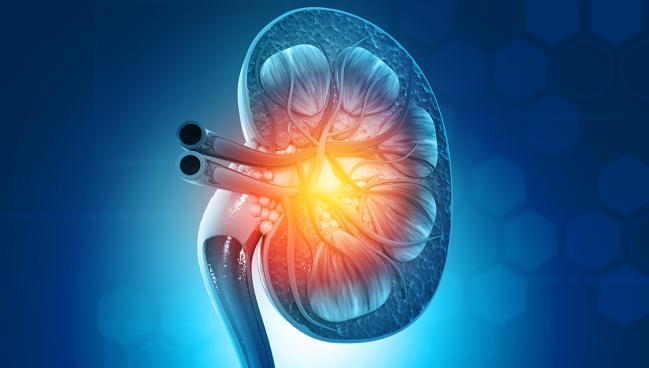Study Supports Cost-effectiveness of Renal Denervation for Hypertension
The technology deserves a place in hypertension treatment, although there are some open questions, one expert says.

Renal denervation using radiofrequency energy is a cost-effective and high-value intervention for the treatment of uncontrolled hypertension from the perspective of the US healthcare system, an analysis published recently online in JSCAI suggests.
Over a lifetime horizon, costs were projected to be higher among patients who are treated with the procedure rather than established standard of care that includes effective antihypertensive medications and lifestyle modification ($96,416 vs $85,141), with about $20,000 of that related to the initial procedure. Denervation was associated with an estimated bump in quality-adjusted life years (QALYs) from 12.49 to 12.83.
That translates into an incremental cost-effectiveness ratio (ICER) of $32,732 per QALY, David Kandzari, MD (Piedmont Heart Institute, Atlanta, GA), and colleagues report. An ICER below $50,000 per QALY indicates an intervention with high value based on standard thresholds.
“Renal denervation therapy falls into that category if you consider, of course, that hypertension is the global leading cause of death and disability and we can achieve quite meaningful reductions in blood pressure with renal denervation therapy,” Kandzari told TCTMD. “As long as the costs of the procedure and the device and the safety of the procedure are acceptable and reasonable, which they all of course are, then the therapy is what might be deemed a dominant or high-value, cost-effective therapy.”
Commenting for TCTMD, Rajesh Swaminathan, MD (Duke University Medical Center and Durham VA Medical Center, NC), lead author of a Society for Cardiovascular Angiography and Interventions position statement on renal denervation, said “we have shown in multiple studies that this technology is safe, efficacious, and now cost-effective.”
Studies have shown drops in BP with the procedure that have been associated with lower risks of death, stroke, and MI, along with reductions in medication burden, he noted.
There are, however, still some open questions about renal denervation, Swaminathan said, highlighting the need to continue enrolling patients in ongoing postmarket registry studies to explore the effects of the procedure in broader groups of patients.
In addition, he said, an area of major interest is how to predict which patients will respond to the intervention, with prior studies showing that 20% to 30% do not have lowered BP after undergoing denervation.
And there still has not been a randomized trial of renal denervation powered to detect an impact on hard clinical outcomes, something that should be feasible considering the number of patients with uncontrolled hypertension, Swaminathan said.
“Now that this is FDA approved and we have it in the hands of folks and people are using it, I think it's not a far leap to do further outcome studies on specific disease states.”
Consistency of Results
After a long, up-and-down research journey, US clinicians gained access to renal denervation in November 2023, when the Food and Drug Administration approved two systems—first the ultrasound-based Paradise system (Recor Medical) and then the radiofrequency-based Symplicity Spyral system (Medtronic)—on the basis of multiple positive sham-controlled trials. Both have broad indications for the treatment of hypertension when lifestyle modification and medications fail to control blood pressure.
Earlier studies had suggested that the procedure would be cost-effective but analyses exploring the issue using more-contemporary data had been lacking, at least within the context of the US healthcare system, Kandzari said.
For the current analysis, he and his colleagues used a decision-analytic Markov model to project costs, QALYs, and clinical events for a group of patients treated with radiofrequency-based renal denervation and controls treated with standard-of-care antihypertensive drugs alone. Patient demographics and treatment effects were derived from the SPYRAL HTN-ON MED trial, which demonstrated a 9.9-mm Hg drop in office systolic BP by 6 months with denervation, 4.9-mm Hg greater than what was observed with the sham intervention, on a background of antihypertensive medications.
The impact of that drop in BP on clinical events was then estimated based on a meta-regression of 47 randomized trials of hypertension treatment. The researchers calculated that renal denervation would lead to absolute reductions in risk of MI by 1.7%, stroke by 3.3%, and cardiovascular death by 3.7% over 20 years, with corresponding numbers needed-to-treat of 59, 31, and 27.
The overall cost-effectiveness of the procedure was relatively consistent across a variety of scenarios and sensitivity analyses. For example, ICERs ranged from $33,040 to $70,846 per QALY for patients ages 45 to 80 years, and from $31,884 to $41,524 per QALY for baseline office systolic BPs ranging from 140 to 175 mm Hg. Cost-effectiveness declined for older patients and those with lower office systolic BPs at baseline.
Still, 91.3% of simulations resulted in a high-value ICER below the threshold of $50,000 per QALY, with all simulations providing an ICER below $150,000 per QALY, indicating at least intermediate value.
Kandzari said these are conservative estimates because they’re based on sham-corrected differences—and not absolute drops—in BP. Moreover, the study population included patients who didn’t respond to the treatment along with those who did. “Even still, the benefits of renal denervation are very cost-effective,” Kandzari said.
He and his colleagues acknowledge several limitations of the analysis, however, including the assumption that the treatment effects observed in trials at 6 months will persist over the long term, use of condition-specific mortality data that were at least 5 years old, and the lack of information on cost-effectiveness across various subgroups defined by race/ethnicity and socioeconomic status. In addition, they say, there are few data to inform resource use and the costs of performing renal denervation in contemporary practice.
Overcoming Reimbursement Challenges
The release of this paper is timely because the Centers for Medicare & Medicaid Services (CMS) will be holding a hearing next month to discuss current procedural terminology (CPT) coding for renal denervation.
“We're at a point in United States practice where it's quite a dilemma,” said Kandzari. “We have FDA approval of the technologies for renal denervation, but we do not have adequate reimbursement, particularly in the outpatient setting where this is most commonly applied.”
In that context, “we're hopeful then that CMS will look favorably on data like this from a cost-effectiveness perspective to help support the reimbursement of this procedure for hospitals and healthcare programs,” he said.
He pointed out that after CMS develops new codes for procedures like renal denervation, private insurers typically follow suit.
Where Will Renal Denervation Fit In?
If these reimbursement issues can be resolved, renal denervation will provide a complementary approach for treating hypertension alongside lifestyle modification and drug therapy, Kandzari said. Multiple documents—including a position paper and comprehensive guidelines from the European Society of Hypertension—have put forth the procedure as a third option when patients are unable to control their BP through conventional means.
The safety and effectiveness of denervation have been established, Kandzari said, adding that “we also know from patient preference studies, that there is a strong desire among a significant number of patients for seeking additional therapies for the treatment of their hypertension rather than just escalating medicines alone.”
Indeed, patients will play a key role in how renal denervation is used, Swaminathan indicated, pointing to the broad indications included on device labeling from the FDA. “I think what that means is we need to have shared decision-making with the patients about what kind of expectations they’re having out of this procedure and what the risk-benefits are.”
Patients who might be best suited for the procedure are those who are already taking several medications and who might have difficulty taking on more or those who are unable to tolerate certain drugs due to side effects, he said.
Renal denervation, Swaminathan said, “deserves implementation in the real-world setting outside of clinical trials. We know it's a very safe procedure.”
In an accompanying editorial, Lucas Lauder, MD (University Hospital Basel, Switzerland), and colleagues say that despite some limitations of the analysis, “these findings are reassuring, as the procedure’s cost-effectiveness is one of the critical questions regarding the clinical adoption of renal denervation.”
They add that even though it might be difficult to perform trials to definitively answer whether renal denervation improves clinical outcomes, it would be “desirable” to do so.
“Although it may be impractical and expensive to carry out outcome studies for renal denervation in hypertension or patients at risk, we should accept the challenge and work toward overcoming the obstacle of conducting cardiovascular outcome trials with modern trial designs and methods,” they write.
Todd Neale is the Associate News Editor for TCTMD and a Senior Medical Journalist. He got his start in journalism at …
Read Full BioSources
Kandzari DE, Cao KN, Ryschon AM, et al. Catheter-based radiofrequency renal denervation in the United States: a cost-effectiveness analysis based on contemporary evidence. JSCAI. 2024;Epub ahead of print.
Lauder L, Burkard T, Mahfoud F. Balancing affordability and need: should we use renal denervation in hypertension management? JSCAI. 2024;Epub ahead of print.
Disclosures
- The study was supported by Medtronic.
- Kandzari reports having received grants and consulting fees from Medtronic, Ablative Solutions, Boston Scientific, Abbott Vascular, OrbusNeich, and Cardiovascular Systems Inc, as well as travel and/or meeting support from Medtronic.
- Swaminathan reports being a sub-investigator for the Global Paradise System US Post Approval Study (US GPS).
- Lauder reports having received speaker honoraria/consulting fees from AstraZeneca, Medtronic, Pfizer, and Recor until May 2024.





Comments